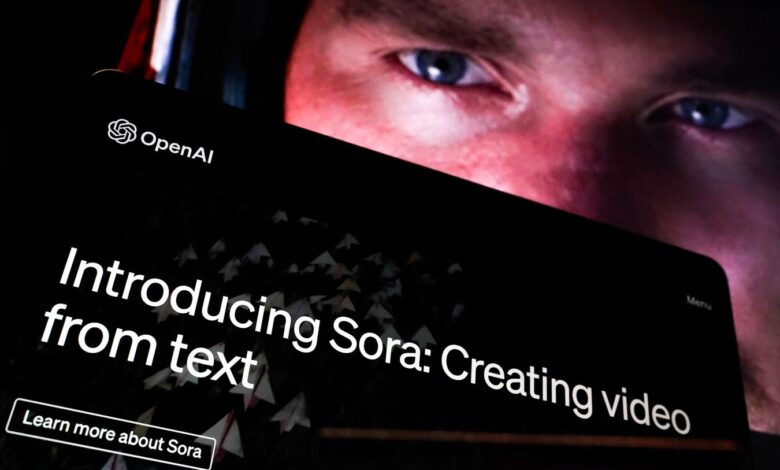Hollywood’s AI Revolution: Innovation Or Impending Disaster?

In this photo illustration, a video created by Open AI’s newly released text-to-video “Sora” tool … [+]
The entertainment world is being turned upside down by the incredible power of artificial intelligence. The brink of a creative revolution arrives on the heels of a bevy of powerful generative AI tools from OpenAI’s Sora to Microsoft’s VASA-1 hitting the market.
Just like how CGI and digital editing transformed filmmaking over the past few decades (like Iron Man’s first suit up in 2008 or the way Game Of Thrones brought Westeros to life), artificial intelligence will place unimaginable new creative tools in the hands of everyone from writers and directors to producers and artists. The recent previews of OpenAI’s Sora have completely made it obvious that artificial intelligence is advancing at an ever increasing pace.
Further driving the point home, the technological marvel of OpenAI’s Sora was quickly eclipsed by Microsoft’s demo of its text-to-video tool, VASA-1. In the demo, VASA-1 exhibited even more realistic video than Sora – with the additional ability to convey emotions that match the tone and cadence of uploaded audio. Unlike OpenAI, Microsoft does not currently plan to release VASA-1 to the general public given its potential for misuse.
All of the recent developments show that generative AI technology is improving at a rate much faster than anyone expected. According to a recent McKinsey & Company report, AI has already achieved the median of human-level creativity, a whopping seven years earlier than they initially predicted back in 2017. This means the impact of AI on the creative process is happening much faster than we ever imagined.
With current AI capabilities, writers can already workshop ideas, develop multi-dimensional characters, and craft intricately-plotted narratives faster than ever. But, with Sora’s natural language capabilities, directors will be able to use AI to create intricate storyboards and pre-visualizations, experimenting with staging, shot composition, VFX, and more before costly physical production even begins. Independent creatives will be able to more efficiently and affordably create entire films.
Given the complex and shifting entertainment market dynamics (declining movie ticket sales, Blu-ray/DVD sales, and TV ad revenue), the implications of such increases in efficiency on the bottom line will not be ignored by studios for long. By 2030, AI is expected to become a $1.5 trillion market – impacting all major industries, with media and entertainment at the forefront of this AI impact.
Live-action movies and TV series aren’t the only content that will benefit from AI. The implications for animated features and video game cinematics are also profound. With tools like Wonder Dynamics, Rokoko and Move AI already available at consumer-level prices, AI is set to revolutionize the labor-intensive and costly animation process.
And although this will democratize access to photoreal CGI, allowing indie creators to compete with Hollywood’s heavy hitters in terms of visual splendor – it will most likely be at the expense of a large number of jobs. Goldman Sachs estimates that artificial intelligence could replace as many as 300 million jobs by 2025.
What This Means For Viewers
As viewers, we’re in for a wild ride too. Artificial Intelligence could lead to hyper-personalized recommendations, interactive narratives that adapt to your choices in real-time, and radically personalize cinematic journeys. Researchers at Columbia University’s Digital Storytelling Lab have already been exploring AI-driven projects like the 2018 Dinner with Frankenstein AI, which could reshape the audience experience entirely.
Of course, with great power comes great responsibility. Incorporating AI raises crucial questions around trust, ethics, and authenticity in entertainment. Let’s be honest, the entertainment industry has never been particularly good at proactively rallying against systemic racism/bias or self governance – unless there is clear profit to be made. During my two decades working in entertainment, I’ve learned that Hollywood vigorously resists change or innovation until someone or something forces its hand – one of the reasons the industry finds itself poised for disruption today.
As the lines between real and AI-generated content blur, viewers may demand more transparency. A 2023 report from Deloitte highlights six substantial risks associated with generative AI in business, including erosion of trust, security concerns, bias and discrimination, data privacy, costs, and potential long-term worker displacements.
Industry leaders will need to step up and ensure the thoughtful, ethical application of these new technologies through self-governance, especially as regulators play catch-up. Given the recent union strikes and Hollywood reactions to AI, industry leaders may initially try to stifle AI development and integration until a new existential threat (or financial opportunity) emerges from small or independent creators who have embraced artificial intelligence.
Despite the challenges, AI could also be a powerful tool for making Hollywood more inclusive. The 2023 UCLA Hollywood Diversity Report reveals that while there have been some gains in on-screen representation, the industry still struggles with inclusivity behind the camera. Women accounted for just 21% of directors and 32% of writers in 2021, while people of color made up only 22% of directors and 27% of writers, despite comprising approximately 43% of the US population as of the 2022 US Census update.
By democratizing access to high-end production capabilities, AI tools like Sora could help lower barriers for marginalized voices and shine a spotlight on boundary-pushing projects that Hollywood’s existing hierarchies often overlook. Just as YouTube and social media enabled a generation of independent creators to bypass traditional gatekeepers, AI could further expand access and visibility for filmmakers and showrunners reflecting the full diversity of our society.
We’re entering an era where stories may no longer be constrained by budgets, locations, sets, or chemistry between fickle human collaborators. With promises of more new stories, formats, and experiential dimensions than we could ever imagine, AI is primed to usher in a new world of creative autonomy and audience interaction. That new world also brings a host of intellectual property and fair use issues that courts and governments are currently ill-equipped to handle.
As with any industrial revolution, it’s also primed to be the cause of major job displacement and tumult in the process – major concerns highlighted during the months-long SAG-AFTRA and WGA strikes in 2023. If there is one thing that is certain, this will definitely be a wild ride.



